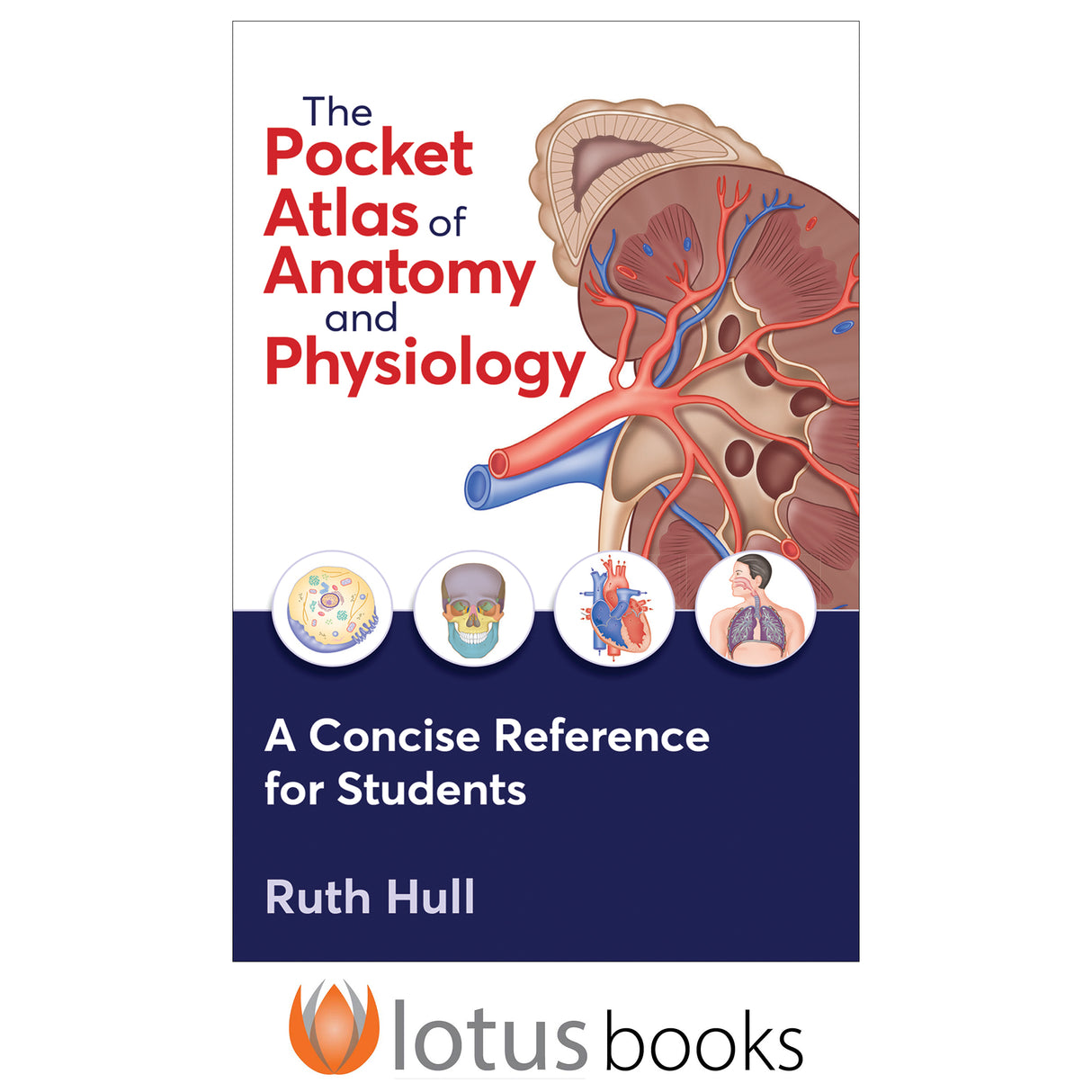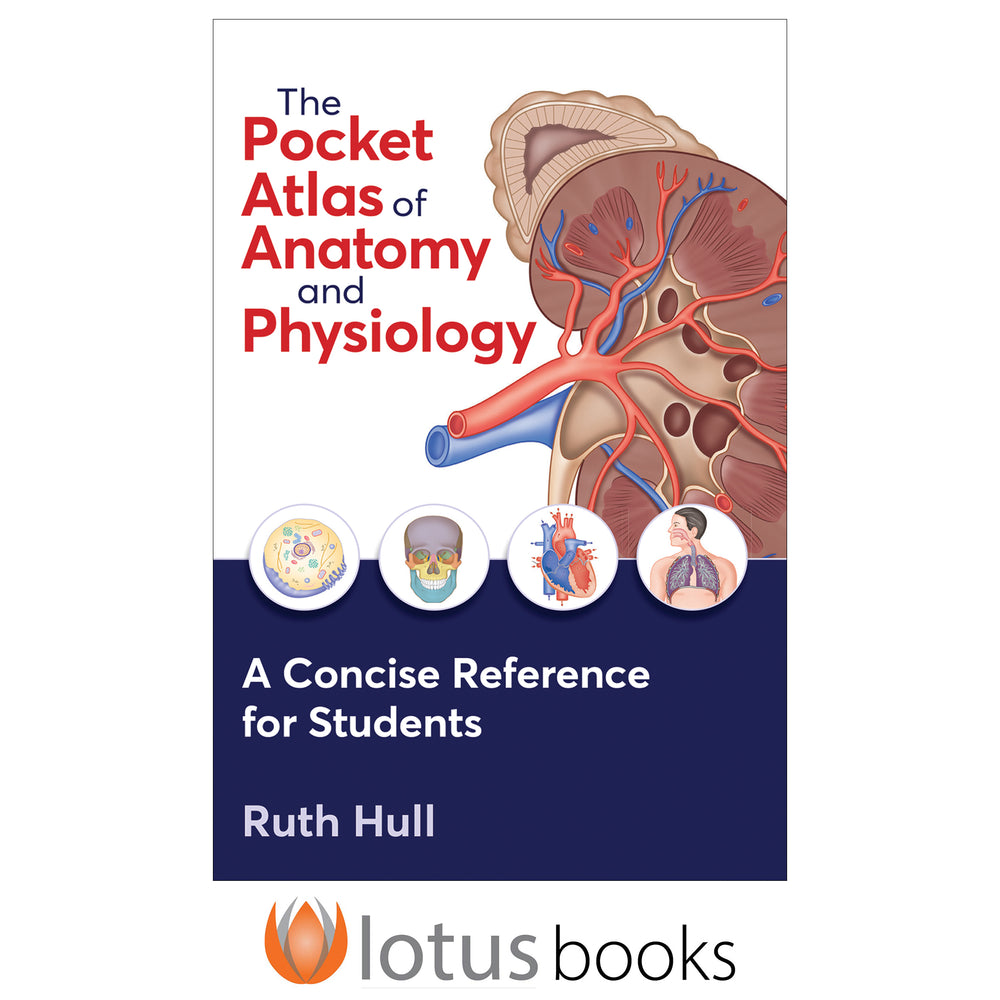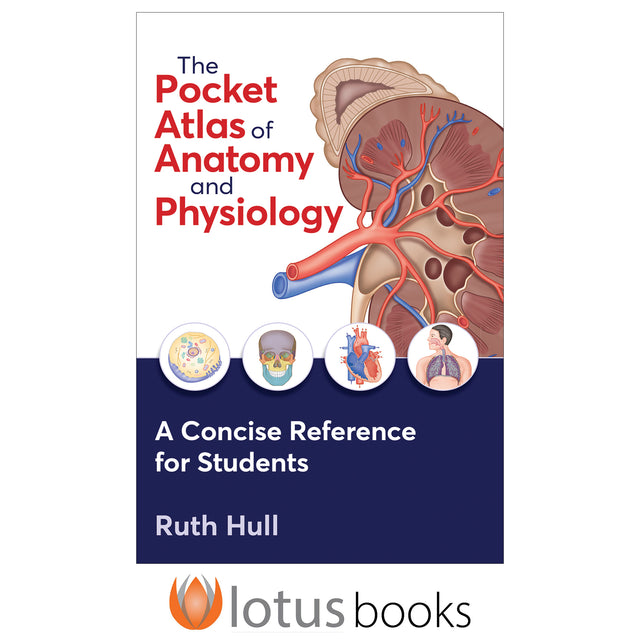Paperback
The Pocket Atlas of Anatomy and Physiology
Author: Ruth Hull
$26.95 CAD
Unit price
/
Unavailable
Paperback
$26.95 CAD
$26.95 CAD
Paperback
Study human anatomy and physiology with full-color illustrations.
The Pocket Atlas of Anatomy and Physiology is the ideal introduction for students of complementary and physical therapies. This pocketbook also serves as an effective refresher for current healthcare and bodywork professionals. It covers the following:
Author and therapist Ruth Hull provides a thorough understanding of anatomy and physiology with clear, concise, and accessible language. The book is designed for easy comprehension, with more than 300 clearly labeled color images, as well as flowcharts and tables to help visualize complex ideas.
The Pocket Atlas of Anatomy and Physiology is the ideal introduction for students of complementary and physical therapies. This pocketbook also serves as an effective refresher for current healthcare and bodywork professionals. It covers the following:
- Skin, hair, and nails
- Skeletal, muscular, and nervous systems
- Endocrine and respiratory systems
- Cardiovascular, lymphatic, and immune systems
- Digestive system
- Urinary system
- Reproductive system
Author and therapist Ruth Hull provides a thorough understanding of anatomy and physiology with clear, concise, and accessible language. The book is designed for easy comprehension, with more than 300 clearly labeled color images, as well as flowcharts and tables to help visualize complex ideas.
Audience
Students and practitioners of anatomy, massage, physical therapy, chiropractic, medicine, nursing, and physiotherapy. Introduction
A Note on American and British Spellings
Chapter 1. Before You Begin
Anatomical Position
Directional Terms
Quadrants
Anatomical Regions
Body Cavities
Planes
Chapter 2. Organization of the Body
Levels of Structural Organization of the Body
Chemical Organization of the Body
Cellular Organization of the Body
Transport across the Plasma Membrane
Life Cycle of a Cell
Tissue Level of Organization of the Body
System Level of Organization of the Body
Theory in Practice
Chapter 3. The Skin, Hair, and Nails
Skin
Types of Skin
Hair
Life Cycle of a Hair
Nails
Cutaneous Glands
Theory in Practice
Chapter 4. The Skeletal System
Bones
Bone Tissue
Compact (Dense) Bone Tissue
Spongy (Cancellous) Bone Tissue
Bone Formation and Remodeling
Types of Bones
Structure of a Long Bone
Organization of the Skeleton
Axial Skeleton
Bones of the Skull
Bones of the Neck and Spine
Bones of the Thorax
Appendicular Skeleton
Bones of the Upper Limb and Shoulder Girdle
Bones of the Pelvic Girdle
Bones of the Lower Limb
The Arches of the Foot
Joints
Synovial Joints
Theory in Practice
Chapter 5. The Muscular System
Muscle Tissue
Skeletal Muscle
Muscle Contraction and Relaxation
Types of Muscular Contraction
Skeletal Muscles and Movement
Muscles of the Body
Muscles of the Face and Scalp
Muscles of the Neck
Muscles of the Trunk and Shoulder
Muscles of the Back
Muscles of the Arm and Forearm
Muscles of the Hand
Muscles of the Hip and Thigh
Muscles of the Leg
Muscles of the Foot
Principal Skeletal Muscles
Theory in Practice
Chapter 6. The Nervous System
Organization of the Nervous System
Nervous Tissue
Structure of a Motor Neuron
Transmission of a Nerve Impulse
Nerves
Brain
Protection of the Brain
Cranial Nerves
Spinal Cord
Spinal Nerves
Special Sense Organs
The Eye
The Ear
The Mouth
The Nose
Theory in Practice
Chapter 7. The Endocrine System
Endocrine Glands and Their Hormones
Hormones Controlled by the Pituitary Gland
Hormones Not Controlled by the Pituitary Gland
The Stress Response
Theory in Practice
Chapter 8. The Respiratory System
Organization of the Respiratory System
The Nose
Paranasal Sinuses
Pharynx (Throat)
Larynx (Voice Box)
Trachea (Windpipe)
Bronchi
Lungs
Alveoli (Air Sacs)
Physiology of Respiration
Pulmonary Ventilation
External Respiration (Pulmonary Respiration)
Internal Respiration (Tissue Respiration)
Theory in Practice
Chapter 9. The Cardiovascular System
Blood
Heart
Walls, Chambers, and Valves of the Heart
Blood Flow to the Heart Tissue
Blood Flow Through the Heart
Physiology of the Heart
Blood Vessels
Blood Pressure
Primary Blood Vessels of Systemic Circulation
Primary Arteries of the Head, Face, and Neck
Primary Veins of the Head, Face, and Neck
Guide to Flowcharts of the Blood Vessels of the Body
Primary Arteries of the Upper Limbs
Primary Veins of the Upper Limbs
Primary Arteries of the Thorax
Primary Veins of the Thorax
Primary Arteries of the Abdomen
Primary Veins of the Abdomen
Primary Arteries of the Pelvis and Lower Limbs
Primary Veins of the Pelvis and Lower Limbs
Theory in Practice
Chapter 10. The Lymphatic and Immune System
The Relationship between the Lymphatic and Cardiovascular Systems
Organization of the Lymphatic and Immune System
Lymph Nodes
Resistance to Disease and Immunity
Non-Specific Resistance to Disease
Immunity (the Immune Response)
Theory in Practice
Chapter 11. The Digestive System
Organization of the Digestive System
Peritoneum
Walls of the GI Tract
Gastrointestinal Tract and Its Accessory Organs
Mouth (Oral or Buccal Cavity)
Esophagus
Stomach
Liver
Gall Bladder
Small Intestine
Pancreas
Large Intestine
Digestion of Carbohydrates
Digestion of Proteins
Digestion of Lipids
Theory in Practice
Chapter 12. The Urinary System
Kidneys
Nephron
Ureters
Urinary Bladder
Urethra
Theory in Practice
Chapter 13. The Reproductive System
Male Reproductive System
Female Reproductive System
Mammary Glands
Female Reproductive Cycle
Aging and the Reproductive System
Theory in Practice
A Note on American and British Spellings
Chapter 1. Before You Begin
Anatomical Position
Directional Terms
Quadrants
Anatomical Regions
Body Cavities
Planes
Chapter 2. Organization of the Body
Levels of Structural Organization of the Body
Chemical Organization of the Body
Cellular Organization of the Body
Transport across the Plasma Membrane
Life Cycle of a Cell
Tissue Level of Organization of the Body
System Level of Organization of the Body
Theory in Practice
Chapter 3. The Skin, Hair, and Nails
Skin
Types of Skin
Hair
Life Cycle of a Hair
Nails
Cutaneous Glands
Theory in Practice
Chapter 4. The Skeletal System
Bones
Bone Tissue
Compact (Dense) Bone Tissue
Spongy (Cancellous) Bone Tissue
Bone Formation and Remodeling
Types of Bones
Structure of a Long Bone
Organization of the Skeleton
Axial Skeleton
Bones of the Skull
Bones of the Neck and Spine
Bones of the Thorax
Appendicular Skeleton
Bones of the Upper Limb and Shoulder Girdle
Bones of the Pelvic Girdle
Bones of the Lower Limb
The Arches of the Foot
Joints
Synovial Joints
Theory in Practice
Chapter 5. The Muscular System
Muscle Tissue
Skeletal Muscle
Muscle Contraction and Relaxation
Types of Muscular Contraction
Skeletal Muscles and Movement
Muscles of the Body
Muscles of the Face and Scalp
Muscles of the Neck
Muscles of the Trunk and Shoulder
Muscles of the Back
Muscles of the Arm and Forearm
Muscles of the Hand
Muscles of the Hip and Thigh
Muscles of the Leg
Muscles of the Foot
Principal Skeletal Muscles
Theory in Practice
Chapter 6. The Nervous System
Organization of the Nervous System
Nervous Tissue
Structure of a Motor Neuron
Transmission of a Nerve Impulse
Nerves
Brain
Protection of the Brain
Cranial Nerves
Spinal Cord
Spinal Nerves
Special Sense Organs
The Eye
The Ear
The Mouth
The Nose
Theory in Practice
Chapter 7. The Endocrine System
Endocrine Glands and Their Hormones
Hormones Controlled by the Pituitary Gland
Hormones Not Controlled by the Pituitary Gland
The Stress Response
Theory in Practice
Chapter 8. The Respiratory System
Organization of the Respiratory System
The Nose
Paranasal Sinuses
Pharynx (Throat)
Larynx (Voice Box)
Trachea (Windpipe)
Bronchi
Lungs
Alveoli (Air Sacs)
Physiology of Respiration
Pulmonary Ventilation
External Respiration (Pulmonary Respiration)
Internal Respiration (Tissue Respiration)
Theory in Practice
Chapter 9. The Cardiovascular System
Blood
Heart
Walls, Chambers, and Valves of the Heart
Blood Flow to the Heart Tissue
Blood Flow Through the Heart
Physiology of the Heart
Blood Vessels
Blood Pressure
Primary Blood Vessels of Systemic Circulation
Primary Arteries of the Head, Face, and Neck
Primary Veins of the Head, Face, and Neck
Guide to Flowcharts of the Blood Vessels of the Body
Primary Arteries of the Upper Limbs
Primary Veins of the Upper Limbs
Primary Arteries of the Thorax
Primary Veins of the Thorax
Primary Arteries of the Abdomen
Primary Veins of the Abdomen
Primary Arteries of the Pelvis and Lower Limbs
Primary Veins of the Pelvis and Lower Limbs
Theory in Practice
Chapter 10. The Lymphatic and Immune System
The Relationship between the Lymphatic and Cardiovascular Systems
Organization of the Lymphatic and Immune System
Lymph Nodes
Resistance to Disease and Immunity
Non-Specific Resistance to Disease
Immunity (the Immune Response)
Theory in Practice
Chapter 11. The Digestive System
Organization of the Digestive System
Peritoneum
Walls of the GI Tract
Gastrointestinal Tract and Its Accessory Organs
Mouth (Oral or Buccal Cavity)
Esophagus
Stomach
Liver
Gall Bladder
Small Intestine
Pancreas
Large Intestine
Digestion of Carbohydrates
Digestion of Proteins
Digestion of Lipids
Theory in Practice
Chapter 12. The Urinary System
Kidneys
Nephron
Ureters
Urinary Bladder
Urethra
Theory in Practice
Chapter 13. The Reproductive System
Male Reproductive System
Female Reproductive System
Mammary Glands
Female Reproductive Cycle
Aging and the Reproductive System
Theory in Practice









